Calving is well under way on this high-performing family farm. When I arrived last Monday, there were 25 cows calved. Two more had calved by the time I left and at time of going to print there were 36 calved. They will be coming thick and fast over the coming weeks. The due date was 3 February, but one thing Brian is finding is that a lot of the cows are calving earlier due to the use of high-EBI bulls.
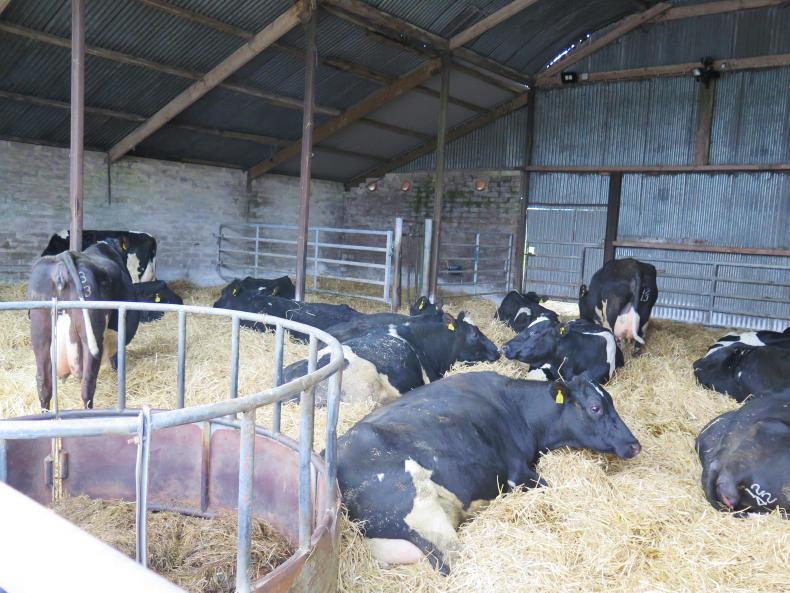
Up to 20 cows can be put into the calving shed.
Apart from one case of milk fever, everything is going according to plan so far. Milk fever was a big issue in 2018 with 10 cows (8% of the herd) down with it. Last year, they sprinkled sweetened cal mag on to the silage for the cows close to calving, and they only had a handful of mild cases. Cows are in excellent body condition score. If anything, they’re overfat. They are also high-yielding, with 540kg MS/cow delivered in 2019. These factors, plus the fact that the soil fertility in silage fields is all index three for potash, means that milk fever is a high risk.
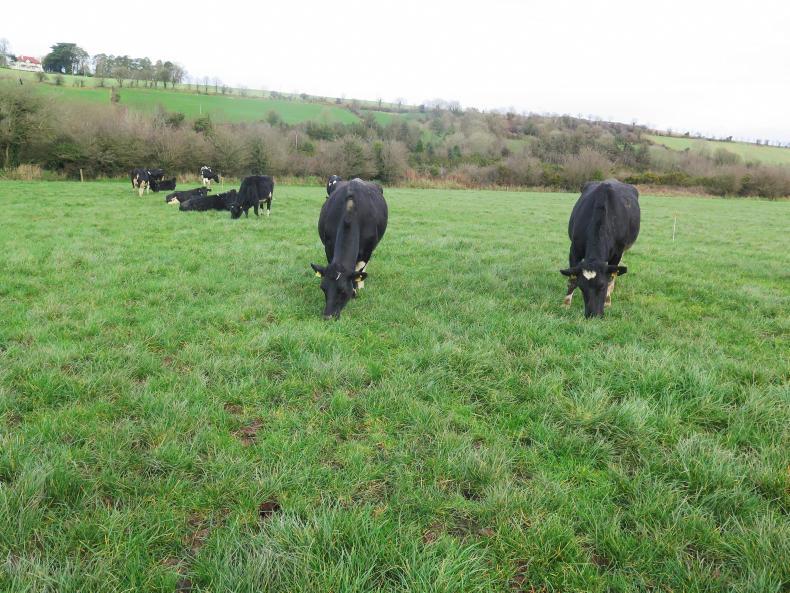
The herd is mostly black and white, with about 20 Jersey cows in total.
The cal mag is fed in addition to the ordinary dry cow minerals, so the cows are getting about 60g of magnesium/day prior to calving. Of the 36 cows calved, only one calved at night. Brian is putting this down to the nighttime feeding of the cows. Silage is dropped in the feed passage of the dry cow shed during the day and pushed in at around 9pm. A round bale of silage is put into a ring feeder in the shed for the cows close to calving.
If the daytime calving trend continues, only six cows will calve at night, which will greatly reduce the workload. Brian is on calving duty until around 11pm. Jerome takes over then, checking cows on the calving camera every few hours during the night. If a cow has calved or is calving, he’ll more than likely get up to feed the calf and move it into one of the individual pens in the calving shed.
Spring Into Action: Desmond farm near Ovens, Co Cork.
The Desmonds are also assisted by CIT agriculture student Tim Forde, who does 40 hours per week as part of his placement from college. Between the three of them, there is no shortage of labour on this farm;
“This is my first spring back home fulltime so we’ve probably excess labour at the moment, but we’ve always taken on a student so we said we’d do the same this spring. I work on a local farm one or two days a week, so having Tim around takes the pressure off Dad on the days I’m not around,” Brian says.
Brian spent the six months before Christmas in New Zealand, as a winner of the Irish Farmers Journal sponsored Stephen Cullinane scholarship. The Desmonds’ long-term goal is to generate two decent incomes from the farm.
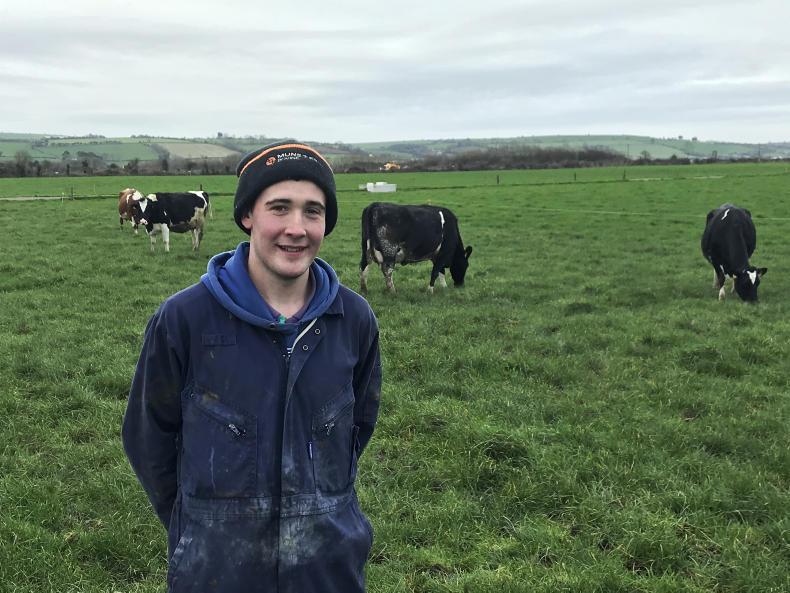
Brian Desmond, Ovens, Co Cork.
Technical performance is already excellent, with almost 15t/ha of grass grown in 2019. The cows are high-producing; average liveweight of the mostly Holstein Friesian/New Zealand Friesian cows is 580kg and they produced 540kg MS/cow from 1t of meal in 2019.
Scale is probably their biggest obstacle. There are 68ha in the farm in total, but less than half of this is on the milking platform. The stocking rate on the overall farm is 2.6 LU/ha, but the milking platform is highly stocked at 3.8 cows/ha, presuming 125 cows will be milked again this year.
“We’d much prefer to be at a lower stocking rate on the milking platform. I think 3.3 cows/ha is more appropriate as there’s less pressure for grass, particularly in spring and autumn. We’d get away with less meal feeding too. But when we do the figures, the farm as a whole makes more money with the milking platform stocked high than it would if we milked 10 or 15 less cows. However, a lower stocking rate would be an easier system to run,” Brian says.
Grass
An opening grass cover was completed last week. The average farm cover is high at 1,044kg/ha and grass growth over the winter was good at 8kg/day.
With the high demand, getting through the grass won’t be a problem. Brian is working on a diet of 4/4/4 at the moment; 4kg of grass, 4kg of meal and 4kg of silage in the shed.
The grass allocation this week was a bit on the high side, with poor cleanout as a result. While it’s OK to be a bit loose on the grazing for the first week or so, Brian says he’ll have to tighten them up or else they’ll be going through too much area. His target is to have 30%, or 10ha of the farm, grazed in February, and 60% or 19ha by St Patrick’s Day.
The farm as a whole makes more money with the milking platform stocked high than it would if we milked 10 or 15 less cows
He has completed a grass budget on PastureBase which is showing that if growth rates are normal, the farm will be at a grass cover of just over 500kg/ha by the start of the second rotation on 3 April.
The plan is to feed a few kilos dry matter of silage and 4kg of meal until mid-March, at which point the silage will be removed and meal will increase to 5kg/cow/day until balance date.
As Brian says, that’s the plan but it’s subject to change depending on the weather and growth rates. Decisions will be guided by information gleaned at the weekly grass walk.
Cows will get silage when they come in at night. They go out for three hours of grazing after the evening milking and then back into the shed for the night. Brian says the silage to the milkers will be eaten during the night, so they’ll have a good appetite for grazing again come morning.
Fertiliser
At this stage, 60% of the farm has been spread with either 23 units/acre of urea or 2,500 gallons/acre of slurry spread with a trailing shoe. The remaining 40% is going to get 23 units/ac of urea this week.
Slurry will be spread with their own splash plate tanker on fields as they are grazed during February. The next application of fertiliser will be 46 units/acre of urea in March. Protected urea has been purchased for use later in the year.
We will revisit this farm in early March.
Read more
New Zealand diary: first-cut silage done and bulls out
Dairy Management: sexed semen, milk fever and heifer weights
Calving is well under way on this high-performing family farm. When I arrived last Monday, there were 25 cows calved. Two more had calved by the time I left and at time of going to print there were 36 calved. They will be coming thick and fast over the coming weeks. The due date was 3 February, but one thing Brian is finding is that a lot of the cows are calving earlier due to the use of high-EBI bulls.

Up to 20 cows can be put into the calving shed.
Apart from one case of milk fever, everything is going according to plan so far. Milk fever was a big issue in 2018 with 10 cows (8% of the herd) down with it. Last year, they sprinkled sweetened cal mag on to the silage for the cows close to calving, and they only had a handful of mild cases. Cows are in excellent body condition score. If anything, they’re overfat. They are also high-yielding, with 540kg MS/cow delivered in 2019. These factors, plus the fact that the soil fertility in silage fields is all index three for potash, means that milk fever is a high risk.

The herd is mostly black and white, with about 20 Jersey cows in total.
The cal mag is fed in addition to the ordinary dry cow minerals, so the cows are getting about 60g of magnesium/day prior to calving. Of the 36 cows calved, only one calved at night. Brian is putting this down to the nighttime feeding of the cows. Silage is dropped in the feed passage of the dry cow shed during the day and pushed in at around 9pm. A round bale of silage is put into a ring feeder in the shed for the cows close to calving.
If the daytime calving trend continues, only six cows will calve at night, which will greatly reduce the workload. Brian is on calving duty until around 11pm. Jerome takes over then, checking cows on the calving camera every few hours during the night. If a cow has calved or is calving, he’ll more than likely get up to feed the calf and move it into one of the individual pens in the calving shed.
Spring Into Action: Desmond farm near Ovens, Co Cork.
The Desmonds are also assisted by CIT agriculture student Tim Forde, who does 40 hours per week as part of his placement from college. Between the three of them, there is no shortage of labour on this farm;
“This is my first spring back home fulltime so we’ve probably excess labour at the moment, but we’ve always taken on a student so we said we’d do the same this spring. I work on a local farm one or two days a week, so having Tim around takes the pressure off Dad on the days I’m not around,” Brian says.
Brian spent the six months before Christmas in New Zealand, as a winner of the Irish Farmers Journal sponsored Stephen Cullinane scholarship. The Desmonds’ long-term goal is to generate two decent incomes from the farm.

Brian Desmond, Ovens, Co Cork.
Technical performance is already excellent, with almost 15t/ha of grass grown in 2019. The cows are high-producing; average liveweight of the mostly Holstein Friesian/New Zealand Friesian cows is 580kg and they produced 540kg MS/cow from 1t of meal in 2019.
Scale is probably their biggest obstacle. There are 68ha in the farm in total, but less than half of this is on the milking platform. The stocking rate on the overall farm is 2.6 LU/ha, but the milking platform is highly stocked at 3.8 cows/ha, presuming 125 cows will be milked again this year.
“We’d much prefer to be at a lower stocking rate on the milking platform. I think 3.3 cows/ha is more appropriate as there’s less pressure for grass, particularly in spring and autumn. We’d get away with less meal feeding too. But when we do the figures, the farm as a whole makes more money with the milking platform stocked high than it would if we milked 10 or 15 less cows. However, a lower stocking rate would be an easier system to run,” Brian says.
Grass
An opening grass cover was completed last week. The average farm cover is high at 1,044kg/ha and grass growth over the winter was good at 8kg/day.
With the high demand, getting through the grass won’t be a problem. Brian is working on a diet of 4/4/4 at the moment; 4kg of grass, 4kg of meal and 4kg of silage in the shed.
The grass allocation this week was a bit on the high side, with poor cleanout as a result. While it’s OK to be a bit loose on the grazing for the first week or so, Brian says he’ll have to tighten them up or else they’ll be going through too much area. His target is to have 30%, or 10ha of the farm, grazed in February, and 60% or 19ha by St Patrick’s Day.
The farm as a whole makes more money with the milking platform stocked high than it would if we milked 10 or 15 less cows
He has completed a grass budget on PastureBase which is showing that if growth rates are normal, the farm will be at a grass cover of just over 500kg/ha by the start of the second rotation on 3 April.
The plan is to feed a few kilos dry matter of silage and 4kg of meal until mid-March, at which point the silage will be removed and meal will increase to 5kg/cow/day until balance date.
As Brian says, that’s the plan but it’s subject to change depending on the weather and growth rates. Decisions will be guided by information gleaned at the weekly grass walk.
Cows will get silage when they come in at night. They go out for three hours of grazing after the evening milking and then back into the shed for the night. Brian says the silage to the milkers will be eaten during the night, so they’ll have a good appetite for grazing again come morning.
Fertiliser
At this stage, 60% of the farm has been spread with either 23 units/acre of urea or 2,500 gallons/acre of slurry spread with a trailing shoe. The remaining 40% is going to get 23 units/ac of urea this week.
Slurry will be spread with their own splash plate tanker on fields as they are grazed during February. The next application of fertiliser will be 46 units/acre of urea in March. Protected urea has been purchased for use later in the year.
We will revisit this farm in early March.
Read more
New Zealand diary: first-cut silage done and bulls out
Dairy Management: sexed semen, milk fever and heifer weights




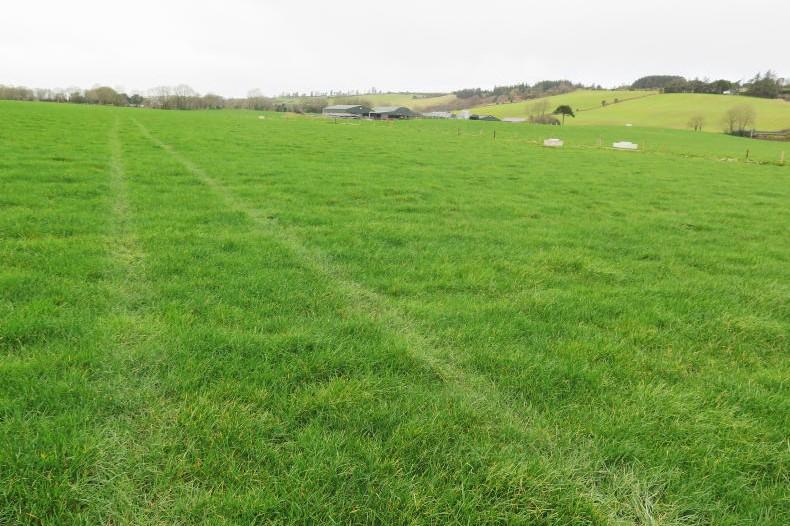




 This is a subscriber-only article
This is a subscriber-only article








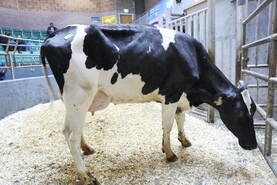
SHARING OPTIONS: